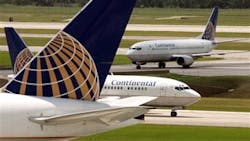Analysts See American, Continental Flying Above Bankruptcy Threat
Unlike two carriers that filed for bankruptcy this week, American Airlines, the nation's largest carrier, has already cut wages sharply, eked out a small profit and piled up more than $3 billion in cash.
Analysts say American and Continental Airlines Inc., the No. 5 carrier, are unlikely to follow rivals Delta Air Lines Inc. and Northwest Airlines Corp. into bankruptcy anytime soon. But American - which barely avoided bankruptcy two years ago - and Continental are also struggling with high fuel prices and big pension obligations.
If Delta and Northwest use the bankruptcy process to dump their pension obligations and cut employees' pay, it could force American and Continental to do the same, analysts say.
"The managements at Delta and Northwest are going to be very aggressive about cutting costs. It's going to be tougher for other legacy carriers like American and Continental to compete against all these bankrupt carriers," said Ray Neidl, an analyst with Calyon Securities.
With the parents of United Airlines and US Airways already reorganizing, four of the six legacy carriers _ those that existed before deregulation in 1978 _ are now in bankruptcy after four years of sluggish business travel, low fares and high fuel prices.
American's parent, Fort Worth, Texas-based AMR Corp., has lost $7.4 billion since the beginning of 2001, yet it may be the strongest financially of the traditional airlines. It earned $58 million in the April-June period, despite a 47 percent jump in fuel costs to $1.35 billion.
More importantly, AMR sits on $3.4 billion in cash and short-term investments.
AMR's relative health is due largely to the fact that it was the first major carrier to sharply cut wages and benefits. In 2003, American's employees agreed to $1.8 billion in annual wage and benefit concessions, most of it from unionized pilots, flight attendants, mechanics and ramp workers.
The airline had lawyers prepared to file bankruptcy papers in New York if the unions voted down the concessions, which left workers "forced to choose between two very bad alternatives," said Ralph Hunter, president of the pilots' union. American also cut thousands of jobs.
Hunter said he doesn't see an immediate risk of bankruptcy but said that American may seek to get more work out of the same number of pilots, or the same amount of work with fewer pilots. He didn't rule out further pay cuts, but suggested that American would have to protect current pension plans to preserve its recently improved relations with the unions.
Chief Executive Gerard Arpey "can't make us do anything," Hunter said. "He has to show us the consequences if we don't do what may need to be done." That said, he added, "I've got some guys who want to burn the place down for what we've already done" on concessions two years ago.
AMR made a $74.4 million payment to the company's pension plans on Wednesday, raising to $287.8 million the contributions for 2005. It had a deficit of about $2.7 billion at the end of 2004, and the company and its unions are lobbying Congress for relief.
The payment was cheered by American's employees, but the new bankruptcy filings were seen as a shot across the bow.
"They're scared _ they would be crazy not to be concerned," said Tommie Hutto-Blake, president of the flight attendants' union at American, referring to the workers.
Hutto-Blake is convinced that Arpey has taken a personal vow to avoid bankruptcy. Still, she said, "maybe the odds are less than 50-50 after yesterday."
While AMR has dodged bankruptcy, Continental is no stranger to the process. It reorganized twice in the 1990s, and many analysts credit that experience with giving the Houston-based carrier lower costs than its rivals.
Last year, Continental set out to cut another $500 million in labor spending and has achieved $418 million of that, while negotiations continue with flight attendants. The company posted a $100 million profit in the second quarter and padded its cash and short-term investments to more than $2 billion.
A spokesman said Continental was better positioned than other network airlines but not immune to rivals getting a cost advantage from bankruptcy protection. He said the company expected to "be a survivor" but that conditions in the industry were more choppy after the latest bankruptcies.
Philip Baggaley, an analyst for Standard & Poor's, said having two more carriers able to shed expenses under bankruptcy protection will pressure American and Continental to further reduce labor costs.
In the short term, however, Baggaley said American and Continental and all other carriers could benefit if Delta and Northwest reduce flights, leading to fewer seats and, in turn, higher fares.
But the legacy carriers banked on high fares until the ascendancy of low-cost airlines such as Southwest Airlines Co. and JetBlue Airways Corp., who took customers away by offering lower fares.
Industry observers doubt that many Delta and Northwest passengers will switch carriers. They said consumers are getting used to bankrupt carriers.
"United filed for Chapter 11 and they're selling all their product," said industry consultant Michael Boyd. "Chapter 11 is just a change in legal proceedings."
AMR shares fell 23 cents, to $11.90, and Continental shares dropped 30 cents, to $11.85, in trading Thursday afternoon on the New York Stock Exchange.
